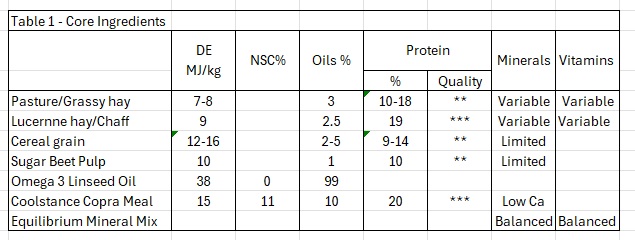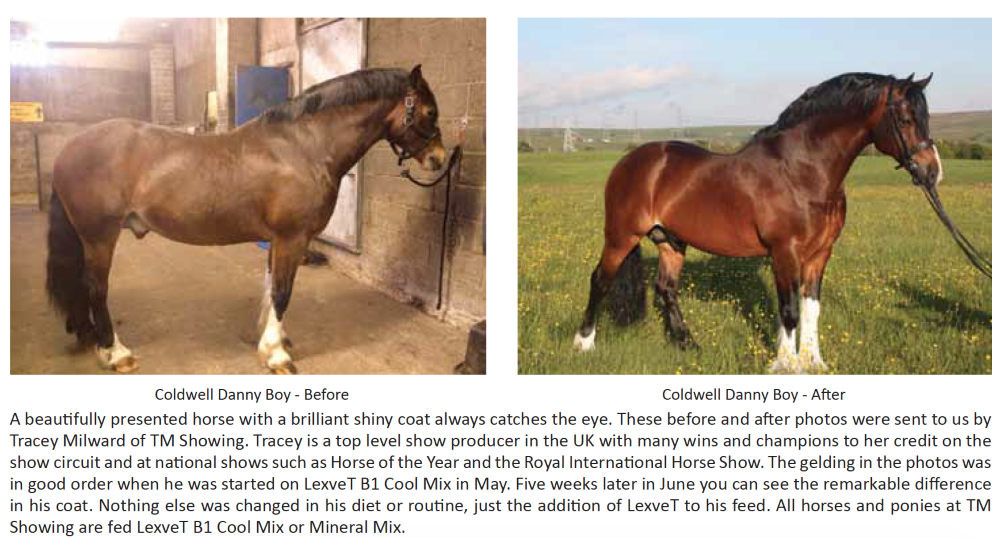Exertional rhabdomyolysis (ER) is muscle pain and cramping generally associated with exercise. It can be sporadic episodes or chronic where there are repeated episodes. Chronic exertional rhabdomyolysis is described as recurrent exertional rhabdomyolysis (RER), which commonly affects Thoroughbreds, Standardbreds and Arab horses. It also accurs with polysaccharide storage myopathy (PSSM) which predominantly affects Quarter horses but also Paints, Warmbloods, Appaloosas, Morgan horses and draft breeds. Nutritional causes linked to ER include electrolyte imbalances or deficiencies, mineral imbalances or deficiencies, vitamin deficiencies and excess grain, starch or sugar in the diet. Oversupplementation can cause mineral and electrolyte imbalances therefore a broad spectrum macro mineral, trace mineral, electrolyte, vitamin and salt supplement is recommended. Horse owners and trainers of horses that have suffered ER should aim for a 100% roughage diet, if concentrates are required, high fibre and high fat products should be fed in preference to starch or sugar feeds.
Also known as founder or foot fever, it is an extremely painful and debilitating condition of the hoof. Blood flow in the hoof is compromised leading to breakdown and degeneration of the union between the horny and sensitive layers of the laminae.
It is a symptom of a generalised metabolic disturbance and can be classified as acute (very severe), subacute (severe), or chronic (milder signs). Rotation of the pedal bone within the hoof may occur in longstanding chronic cases and can even perforate the sole of the foot.
The most common causes are excess carbohydrates (grain overload) or grazing lush pastures. Excess sugars and starches ferment in the hind gut leading to lactic acid buildup killing normal gut bacteria and releasing endotoxins. The endotoxins are absorbed into the bloodstream and travel to the hoof where they interfere with normal blood flow. The blood flow is dramatically reduced with sludging and emboli occuring in the capillaries. The reduced oxygen perfusions means that the hoof wall starts to degenerate and break down, resulting in the clinical signs of laminitis.
To prevent grain overload all horses should be fed roughage adlib and minimal concentrates added when required. For horses that are susceptible to pasture induced laminitis, download our laminitis fact sheet from our website.
Defined as abdominal pain it is the most frequent cause of emergency treatment and death in horses. Risk factors include diet, internal parasitism, medical history, management and weather-related factors. A change in feeding program, amount of concentrate fed, access to pasture, type of forage and water intake are associated with the greatest risk of colic. Horses fed more than 2.5kg of concentrates per day are five times more likely to colic than horses on 100% roughage diets (Tinker et al., 1997) A decrease in pasture availability (either no pasture, reduction in paddock size or reduction in time on pasture) tripled the risk of colic (Hudson et al. 2001). Meal feeding concentrates exaggerates fermentation, resulting in decreased pH and altering fluid balance, resulting in intestinal distention or impaction colic (Clarke et al, 1990). Studies have shown implementing high roughage minimal concentrate feeding programs will reduce the risk of colic.
References
Aldred, J. (1998). Developmental orthopaedic disease in horses. Rural ind. Res. Develop. Corp. Publ. 97/79:1-31
Clarke, L.L., Roberts, M.C, Argenzio, R.A. (1990), Feeding and digestive problems in horses - physiological responses to a concentrated meal. Vet. Clin. North American Equine Practice 6:433 - 450.
Connysson M., Essen-Gustavsson B., Lindberg J.E., Jansson A. (2010), Effects of feed deprivation on Standardbred horses fed a forage-only diet and a 50:50 forage-oats diet. Equine Veterinary journal, 42: 335-340.
Ellis J.M., Hollands T., Allen D.E. (2002), Effect of forage intake on bodyweight and performance. Equine veterinary Journal, 34: 66-70.
Gibbs, P.G, Sigler, S.H., Goehring, T.B. (1989), Influence of diet on growth and development of yearling horses. Journal of Equine Veterinart Science; 9, 215 - 218.
Glade, M.J., (1983), Nutrition and performance of racing Thoroughbreds. Equine Veterinary Journal, 15: 31-36.
Glade, M.J., (1989), Effects of specific amino acid supplementation on lactic production by horses exercise on a treadmill. Proc Eleventh Equine Nutr Physiol Symp 1989:244
Hudson, J.M., Cohen, N.D., Gibbs, P.G., Thompson, J.A., (2001) Feeding practices associated with colic in horses. Journal American Veterinary Medicine Association 219:1414 - 1425
Hurtig, M., Green, S.L., Dobson, H., Mikuni - Takagaki, Y. and Choi, J. (1993) Correlative study of defective cartilage and bone growth in foals fed a low copper diet. Equine Veterinary Journal Supplements; 16, 66 - 73
Jansson A., Lindberg J.E. (2012), A forage-only diet alters the metabolic response of horses in training. Animal, 6, pp1939-1946.
McLean B.M.L. Hyslop J.J., Longland A.C., Cuddeford D., Hollands T. (2000), Physical processing of barley and its effects on intra-caecal fermentation patterns in ponies. Animal Feed Science and Techonology 85, 79-87.
Meyer, H., (1987), Nutrition and the equine athelete. Equine Exer Physiol 1987;2:644
NRC (2007), Nutrient Requirements of Horses, Sixth Revised Edition, National Academies Press.
Savage, C.J., McCarthy, R.N. and Jeffcott, L.B. (1993) Effects of dietary phosphorus and calcium on induction of dyschondroplasia in foals. Equine Veterinary Journal Supplement; 16, 80 - 83
Tinker, M.K., White, N.A., Lessard, P., Thatcher, C.D., Pelzer, K.D., Davis ,B., Carmel, D.K. (1997) Prospective study of equine colic risk factors. Equine Veterinary Journal 29: 454 - 458
Vervuert I., Voigt K., Hollands T., Cuddeford D., Coenen M., (2008a), The effect of processing barley on its digestion by horses. The Veterinary Records 162, 984-688








